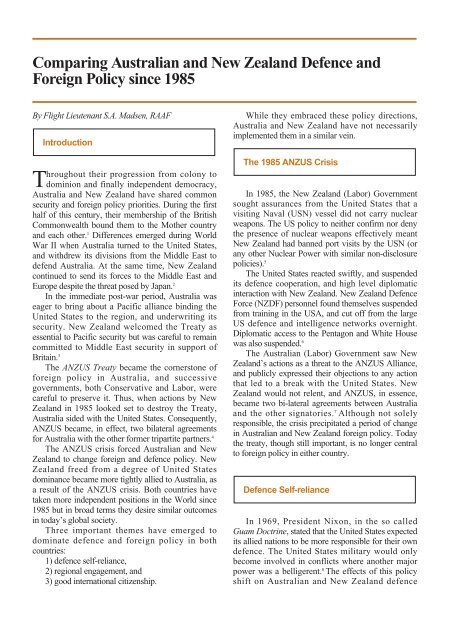ISSUE 136 : May/Jun - 1999 - Australian Defence Force Journal
ISSUE 136 : May/Jun - 1999 - Australian Defence Force Journal
ISSUE 136 : May/Jun - 1999 - Australian Defence Force Journal
- No tags were found...
You also want an ePaper? Increase the reach of your titles
YUMPU automatically turns print PDFs into web optimized ePapers that Google loves.
Comparing <strong>Australian</strong> and New Zealand <strong>Defence</strong> andForeign Policy since 1985By Flight Lieutenant S.A. Madsen, RAAFIntroductionThroughout their progression from colony todominion and finally independent democracy,Australia and New Zealand have shared commonsecurity and foreign policy priorities. During the firsthalf of this century, their membership of the BritishCommonwealth bound them to the Mother countryand each other. 1 Differences emerged during WorldWar II when Australia turned to the United States,and withdrew its divisions from the Middle East todefend Australia. At the same time, New Zealandcontinued to send its forces to the Middle East andEurope despite the threat posed by Japan. 2In the immediate post-war period, Australia waseager to bring about a Pacific alliance binding theUnited States to the region, and underwriting itssecurity. New Zealand welcomed the Treaty asessential to Pacific security but was careful to remaincommitted to Middle East security in support ofBritain. 3The ANZUS Treaty became the cornerstone offoreign policy in Australia, and successivegovernments, both Conservative and Labor, werecareful to preserve it. Thus, when actions by NewZealand in 1985 looked set to destroy the Treaty,Australia sided with the United States. Consequently,ANZUS became, in effect, two bilateral agreementsfor Australia with the other former tripartite partners. 4The ANZUS crisis forced <strong>Australian</strong> and NewZealand to change foreign and defence policy. NewZealand freed from a degree of United Statesdominance became more tightly allied to Australia, asa result of the ANZUS crisis. Both countries havetaken more independent positions in the World since1985 but in broad terms they desire similar outcomesin today’s global society.Three important themes have emerged todominate defence and foreign policy in bothcountries:1) defence self-reliance,2) regional engagement, and3) good international citizenship.While they embraced these policy directions,Australia and New Zealand have not necessarilyimplemented them in a similar vein.The 1985 ANZUS CrisisIn 1985, the New Zealand (Labor) Governmentsought assurances from the United States that avisiting Naval (USN) vessel did not carry nuclearweapons. The US policy to neither confirm nor denythe presence of nuclear weapons effectively meantNew Zealand had banned port visits by the USN (orany other Nuclear Power with similar non-disclosurepolicies). 5The United States reacted swiftly, and suspendedits defence cooperation, and high level diplomaticinteraction with New Zealand. New Zealand <strong>Defence</strong><strong>Force</strong> (NZDF) personnel found themselves suspendedfrom training in the USA, and cut off from the largeUS defence and intelligence networks overnight.Diplomatic access to the Pentagon and White Housewas also suspended. 6The <strong>Australian</strong> (Labor) Government saw NewZealand’s actions as a threat to the ANZUS Alliance,and publicly expressed their objections to any actionthat led to a break with the United States. NewZealand would not relent, and ANZUS, in essence,became two bi-lateral agreements between Australiaand the other signatories. 7 Although not solelyresponsible, the crisis precipitated a period of changein <strong>Australian</strong> and New Zealand foreign policy. Todaythe treaty, though still important, is no longer centralto foreign policy in either country.<strong>Defence</strong> Self-relianceIn 1969, President Nixon, in the so calledGuam Doctrine, stated that the United States expectedits allied nations to be more responsible for their owndefence. The United States military would onlybecome involved in conflicts where another majorpower was a belligerent. 8 The effects of this policyshift on <strong>Australian</strong> and New Zealand defence

















